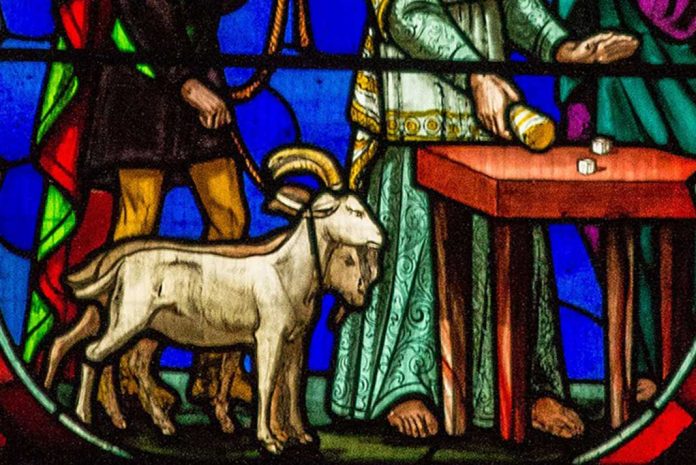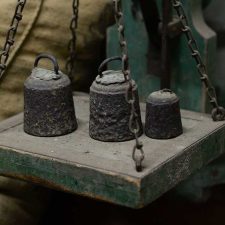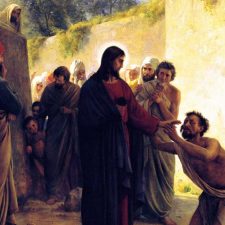Daniel 9:24: “Seventy weeks are determined upon thy people and upon thy holy city, to finish the transgression, and to make an end of sins, and to make reconciliation for iniquity, and to bring in everlasting righteousness, and to seal up the vision and the prophecy, and to anoint the most Holy.”
I suppose every explanation of this verse I have ever heard assumes this is referring to the work of Jesus the Messiah in his crucifixion. But I question whether the soteriological (salvation) work of Jesus by his crucifixion is what this verse is referring to. Jesus’ work of atonement for sin was only applicable for a small remnant of Jews. This was not a prophecy about the salvation of that small remnant, this was about the Jewish nation and the city of Jerusalem. The question then is, what stopped the Jewish people’s transgression of God’s Law? What ended their sins against God? What made atonement for the guilt of the nation? What set right Israel’s history of breaking covenant with God? What closed the books on vision and prophecy? And what cleansed the most Holy place on earth? The short answer is death.
God has laid out for us a very detailed legal process for how atonement for sin is made, and everything that Jesus did was done according to every jot and tittle of the Law. So, it’s important to understand what the Law required to make atonement for sin, to stop transgressions of God’s Law, to expiate guilt, to cleanse the unclean. The ordinances that governed how this was to be accomplished, how atonement was to be made, comprised one of the seven “feasts” of the Jewish calendar outlined in Leviticus 23:26-32, the “Day of Atonement.” The explicit directions on how that feast was to be observed, the actual mechanics of making atonement, is laid out in great detail in Leviticus 16.
It is a great misfortune for the church today that the premillennial futurist view of these feasts and what they foreshadowed dominates so much of the discussion. The popular eschatological view is that the spring feasts foreshadowed Jesus’ 1st Advent, and the fall feasts foreshadow his future 2nd Advent. But there is a serious issue with such a view and what it means for the Gospel and its soteriology (doctrines of salvation). One of the fall feasts was the Day of Atonement, that one and only day of the Jewish calendars when atonement for sin could legally be made. If Jesus has not yet fulfilled what that feast and all its ordinances foreshadowed, then Jesus has not yet made atonement for sin! I trust the implications of such a view are self-evident. It is a repudiation of the most fundamental doctrine of the Gospel, that salvation is through faith in the shed blood of Jesus Christ to atone for sin. With that in mind, let’s take a look at what the Day of Atonement required and what it means for the Gospel.
In order to make atonement for the sins of the people, two goats were required. The High Priest cast lots to determine which goat was “for Jehovah,” and which goat was “for Azazel.” Now at this point the popular interpretation is that the goat “for Azazel” foreshadowed the sacrificial death of Jesus. But there’s a problem with that interpretation. It was actually the goat “for Jehovah” that foreshadowed Jesus. The goat “for Jehovah” was sacrificed, and this goat’s body was offered on the altar of burnt offerings and this goat’s blood was carried into the Most Holy and presented to God to make atonement for sin. But the High Priest’s ministry was not complete once that blood was sprinkled in the Holy of Holies. Then the blood of this goat was sprinkled in all the holy places and on all the furnishings and vessels of ministry, and thereby cleansed all the Holy House to make fit a dwelling place for God.
This was a shadow of how New Covenant atonement works, that Jesus, the sacrifice “for Jehovah,” was slain, and after his resurrection, as both the Sacrifice and the High Priest of the New Covenant, Jesus ascended into heaven and appeared in the presence of God to offer himself an Ever-Living Sacrifice to make atonement once-and-forever for the sin of those who enter into the New Covenant. But like that Old Covenant High Priest, Jesus’ ministry of atonement was not finished when he offered himself to God. As Paul teaches us in Hebrews 9, for those whose sins are atoned through faith in the blood of Jesus, our High Priest “sprinkles” us with his blood, and thereby “purges our conscience” (purifies our awareness and understanding of what is right and what is wrong) cleansing us “from dead works” (from thinking that righteousness is about conforming our outward behavior to the letter of the Law – legalism) so that the Spirit of God might enter into us and dwell in us who have been made clean by the blood of Jesus, and are thereby made fit to be a holy temple where the Spirit of God dwells, and the holy vessels of His ministry, so that we might know God and in coming to know Him we might serve Him in spirit and in truth, not according to the Old Testament letter of the Word (which kills), but according to the New Testament spirit of the Word (which gives life).
So if the goat “for Jehovah” foreshadowed Jesus’ sacrificial death and offering of his body and blood in the presence of God as atonement for sin, what did the other goat that the Law required for atonement, the goat “for Azazel,” foreshadow? Over the years there has been a lot of chatter about Azazel and what that goat foreshadowed, and the popular interpretation is that this goat foreshadowed Jesus. But let’s take another look at that. The word “for Azazel” means “for departure.” There is a lot to unpack there, but to look closely at the ordinances concerning this goat, the High Priest laid his hands on the head of this goat and confessed all of Israel’s sins upon his head, and this goat was not sacrificed and its body and blood was not offered up in the Holiest or sprinkled on the temple and its furnishings and vessels of ministry, but this goat, bearing the sins of Israel upon its head, was led out into the wilderness where it was “let go” (Azazel came to be called the goat “for letting go”) to wander in the wilderness until it perished. This goat was also sacrificed to make atonement for sin, but not in the same way as the goat “for Jehovah.” This goat, which is translated “scapegoat” (the one who bears the blame) foreshadowed what Daniel 9:24 was foretelling: those Jews whose sins were not atoned by Jesus bore their sins upon their own heads and when the time for the final judgment of the Law was fulfilled so that the Old Covenant could pass away, those unsaved Jews were “let go” to “wander in the wilderness” where they perished, just like that generation of old that was led out of Egypt who, because of their unbelief, were left to wander for 40 years and finally perish in the wilderness and never entered into the Promised Land.
So according to the Law, two goats were required to make atonement for sin. Daniel 9:24 was talking about 70 weeks that were decreed for the Jewish nation and the city of Jerusalem to atone for the sins of the nation that were NOT covered by the blood of Jesus, but they bore their sins upon their own heads and wandered for 40 years until they perished in the wilderness of this old world and never entered into that heavenly country to which their fathers had lifted their eyes and set their hearts.
The Gospel, the Law, and history all testify that the vast majority of Daniel’s people rejected the atonement for sin provided by Jesus, the goat “for Jehovah,” and therefore God stopped their transgressing, ended their sins, made atonement for their guilt, set things right, closed the book on visions and prophecy, and cleansed the holy places that had been defiled by Israel’s history of shedding innocent blood, by an awful seven year war in which millions of Jews were slaughtered, the land of Israel was made a desolate wasteland, the Holy City was burned up, and the Temple where God had once dwelled was leveled. That last generation of Jews living under the Old Covenant paid the ultimate price for a history of breaking covenant with God.
But those Jews whose sins were covered by the blood of the Lamb, whose sins were atoned by the sacrifice of Jesus, the “goat for Jehovah,” though they were but a small remnant of a nation who were as the stars of the heavens for multitude, that small remnant of Jews who laid down their lives for the testimony of Jesus, they are the Israel of the New Covenant, a chosen generation, and the foundation on which Jesus has built his church.
A lifelong student of New Testament history and archaeology, Deborah L. Bray was thrilled and honored to work with the Israel Antiquities Authority at the American Exhibit of the Dead Sea Scrolls. Through a state-of-the-art virtual reality theater, one of only four in the U.S., using a program developed by the imminent archaeological architect Leen Ritmeyer and the team at Cal Tech University, Deborah hosted virtual reality tours of the ancient city of Jerusalem and the Herodian Temple Mount as they existed in New Testament times, sharing the fruits of her many years of study with over a quarter million visitors to the exhibit. Over the decades, it has been through her countless hours of Bible study and forum discussions with fellow Christians where Deborah has found her greatest passion as a Christian apologist and, more recently, an aspiring novelist. Her ongoing work is available at dlbray.com, “The Life and Times of Jesus“–where faith and history meet.














